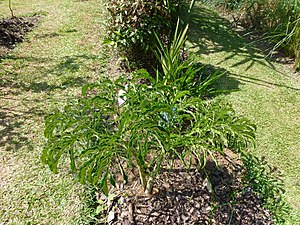Note: This is a project under development. The articles on this wiki are just being initiated and broadly incomplete. You can Help creating new pages.
Difference between revisions of "Amorphophallus campanulatus"
(→References) |
|||
| Line 1: | Line 1: | ||
{{stub}} | {{stub}} | ||
[[File:Amorphophallus campanulatus-Jardin botanique de Kandy.jpg|thumb|right]] | [[File:Amorphophallus campanulatus-Jardin botanique de Kandy.jpg|thumb|right]] | ||
| − | + | '''Amorphophallus campanulatus (Roxb.)''' Blume (Araceae) is commonly known as Elephant foot yam. Corms are used in India in curries and pickles and are ascribed in vitiated conditions of vata and kapha, anaemia and general debility. | |
==Uses== | ==Uses== | ||
{{Uses|Piles}}, {{Uses|Dysentery}}, {{Uses|Acute rheumatism}}, {{Uses|Snakebites}},{{Uses|Diarrhoea}}. | {{Uses|Piles}}, {{Uses|Dysentery}}, {{Uses|Acute rheumatism}}, {{Uses|Snakebites}},{{Uses|Diarrhoea}}. | ||
Revision as of 15:10, 20 March 2020
Amorphophallus campanulatus (Roxb.) Blume (Araceae) is commonly known as Elephant foot yam. Corms are used in India in curries and pickles and are ascribed in vitiated conditions of vata and kapha, anaemia and general debility.
Contents
- 1 Uses
- 2 Parts Used
- 3 Chemical Composition
- 4 Common names
- 5 Properties
- 6 Habit
- 7 Identification
- 8 List of Ayurvedic medicine in which the herb is used
- 9 Where to get the saplings
- 10 Mode of Propagation
- 11 How to plant/cultivate
- 12 Commonly seen growing in areas
- 13 Photo Gallery
- 14 References
- 15 External Links
Uses
Piles, Dysentery, Acute rheumatism, Snakebites,Diarrhoea.
Parts Used
Chemical Composition
Standard β-sitosterol was procured from Sigma-Aldrich (Steinheim, Germany). Solvents used to prepare mobile phase solutions were of HPLC grade and purchased from Merck (Germany). [1]
Common names
| Language | Common name |
|---|---|
| Kannada | |
| Hindi | |
| Malayalam | |
| Tamil | |
| Telugu | |
| Marathi | |
| Gujarathi | |
| Punjabi | |
| Kashmiri | |
| Sanskrit | |
| English |
Properties
Reference: Dravya - Substance, Rasa - Taste, Guna - Qualities, Veerya - Potency, Vipaka - Post-digesion effect, Karma - Pharmacological activity, Prabhava - Therepeutics.
Dravya
Rasa
Guna
Veerya
Vipaka
Karma
Prabhava
Habit
Identification
Leaf
| Kind | Shape | Feature |
|---|---|---|
Flower
| Type | Size | Color and composition | Stamen | More information |
|---|---|---|---|---|
| {{{5}}} |
Fruit
| Type | Size | Mass | Appearance | Seeds | More information |
|---|---|---|---|---|---|
Other features
List of Ayurvedic medicine in which the herb is used
Where to get the saplings
Mode of Propagation
How to plant/cultivate
A temperature in the range of 25 - 35°c is required with an annual rainfall of 1,000 - 1,500mm.[3]
Commonly seen growing in areas
Secondary forests, Shrub forests, Grasslands.
Photo Gallery
References
- ↑ Chemistry
- ↑ [Morphology]
- ↑ Cultivation
External Links
- Pages that are stubs
- Ayurvedic Herbs known to be helpful to treat Piles
- Ayurvedic Herbs known to be helpful to treat Dysentery
- Ayurvedic Herbs known to be helpful to treat Acute rheumatism
- Ayurvedic Herbs known to be helpful to treat Snakebites
- Ayurvedic Herbs known to be helpful to treat Diarrhoea
- Herbs with Young leaves used in medicine
- Habit - Perennial
- Index of Plants which can be propagated by Seeds
- Herbs that are commonly seen in the region of Secondary forests
- Herbs that are commonly seen in the region of Shrub forests
- Herbs that are commonly seen in the region of Grasslands
- Herbs
- Pages without herbs images

